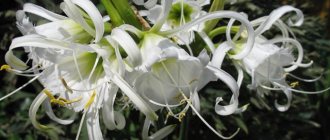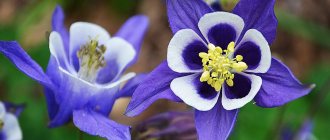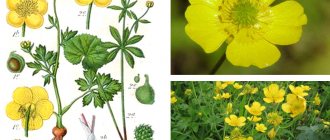The lycoris flower comes from the East; in its homeland there are legends around it; people believe that it has mythical properties. In Russia, gardeners grow lycoris in dachas and houses as an indoor flower. And it received the mythical name “flower of death” due to its frequent location near cemeteries. In terms of agricultural technology, it is similar to tulips and daffodils, so caring for it is easy if you follow the general recommendations. This is one of the main reasons why the choice is made in favor of lycoris.
Features and use of lycoris in decoration: photos and videos
Licorice is a perennial plant from the amaryllis family, all parts of which are poisonous. The length ranges from 30 to 70 cm. It is propagated by bulbs whose diameter is 5 cm. The tip of the shoot is decorated with an inflorescence of large buds. One bulb produces 5-7 flowers per season.
Licorice in Japan
On the site, lycoris is planted in the border, in the flowerbed. The plant feels best when planted in a group. Low-growing flowers are chosen as neighbors. Original gardeners for the group choose ferns, crocuses, hostas, and begonias.
A popular topic is the design of small ponds. Next to them are placed a boulder, lycoris and iris.
Botanical description of lycoris
Spider lilies are perennial plants of the Amaryllis family. In total, there are about 20 varieties of lycoris, which grow in the countries of South and East Asia - India, South Korea, Japan, Laos, Pakistan, Nepal.
Botanical features of the lycoris flower:
- Licorice is a bulbous plant. Its bulbs are quite large, 5-6 cm in diameter.
- The leaves are belt-shaped, narrow, up to 40-50 cm long. Lycoris foliage has a rich and bright green color.
- At the end of June or beginning of July, the leaves die off and in their place stems up to 50-70 cm long are formed.
- When lycoris blooms depends on its growing conditions. Most often, large buds appear in September. From 5 to 7 inflorescences are formed on one stem. The flowering process lasts from 10 to 15 days.
- Lycoris buds have an unusual, original shape - they look like lilies, but their stamens look like cobwebs, which is why the plant came to be called “spider lilies.”
- Licorice has a variety of colors - depending on the variety, the flowers can be golden yellow, orange, crimson red, lilac or silvery white.
One of the main characteristics of the lycoris flower is that its flowers and leaves never “meet” each other.
The flowering of the plant lasts up to 15 days, after which the inflorescences begin to fade. Only after this does the formation of arrow-shaped leaves begin, which persist throughout the winter, until the end of May.
Main types of culture
As of 2021, 20 species of lycoris are registered. Only 4 species grow in Russia:
| View | Description | Growing conditions and nuances |
| Lycoris radiata - radiant lycoris | The massive leaf blades of the plant bend towards the edges. The large flowers come in red, white and hot pink. The stamens are elongated. Height - from 30 to 70 cm. The rosette appears in the spring, and the flowers themselves bloom by the beginning of autumn. | One of the unpretentious types of lycoris. It grows well both in southern and central Russia. |
| Lyc oris squamigera - scaly lycoris | There are 8-9 buds on one inflorescence. The petals of the flower are light pink with a lilac tint and a yellow center, slightly curved back. Plant height is from 60 to 70 cm. Flowers bloom in mid-August. | The most cool-loving type of lycoris plant. Withstands frosts down to -30 degrees Celsius without additional shelter. The only nuance of planting is the soil. It should be well drained and moisturized. |
| Lycoris sanguinea - blood red lycoris | The height of the plant does not reach 45 cm. Small leaves 15-20 mm wide grow in April. By the end of June they are already dying. The peduncle contains 5-6 scarlet buds, which bloom at the end of August. | This type of lycoris loves well-drained soils and warmth. Grows in open ground in the southern regions of Russia. |
| Lycoris aurea - golden lycoris | The height of the plant is forced from 50 to 60 cm. From 4 to 6 flowers grow on one peduncle. The flowers are large, poisonous yellow. Flowering occurs in the second half of May or early June. | The variety has low frost resistance, so it can only germinate in the southern zone of Russia. |
Lycoris radiata
Lycoris squamigera
Lycoris aurea
For cultivation in Moscow and the Moscow region, plant species such as radiant or scaly lycoris are suitable. They best tolerate climate conditions - frosts, frequent rains.
Licorice often becomes an inhabitant of the plot and windowsill, due to its significant advantages:
- unpretentiousness, ease of care;
- there are practically no problems with pests;
- lush flowering;
- multiplies quickly.
But this plant also has disadvantages that need to be remembered:
- short flowering - about 1 month;
- poisonous;
- requires a well-chosen place for planting.
Main varieties of spider lily
Various types of hymenocallis, crinum and lycoris are commonly called spider lilies because their flowers are very reminiscent of a spider.
| Genus name | Species name | Latin name | Species description |
| Hymenocallis or Hymenocallis | Caribbean | N. caribaea | Represented in floriculture by such varieties as “Tropical Giant” and “Tropical Giant Sister” |
| Beautiful | H. speciosa | A small plant with very graceful and delicate flowers | |
| broadleaf | H. latifolia | Year-round blooming species with large foliage and fragrant flowers | |
| Tubeflower | H. tubiflora | An evergreen plant with fragrant and beautiful inflorescences | |
| Holly | H. acutifolia | The leaves are attractive, pointed, and bloom in late summer or early fall. | |
| Aztec | H. azteciana | Medium vigor, with fragrant star-shaped flowers | |
| Maximillian | H. maximillianii | Compact, upright plant with attractive | |
| West | H. occidentalis | Medium-sized bush, with gray-green leaves and inflorescences of several large flowers | |
| Krinum or Crinum | Mura crinum | C. moorei Hook. f. | About ten flowers are collected in an umbrella-shaped inflorescence, rising low above the leaf rosette |
| Powell crinum | C. powellii | There are 6-8 large pinkish flowers on the peduncle | |
| Asian croonim | C. asiaticum | The inflorescence is represented by an umbrella with 20-50 flowers on shortened stalks | |
| Pleasant crinum | C. amabile | The flowers are bright red with purple and whitish tints, very fragrant | |
| Cape crinum | S. bulbispermum | The flowers are white, occasionally with a purple tint, large in size, fragrant | |
| Lycoris or Lycoris | Scaly lycoris | L. squamigera | Fragrant lilac funnel-shaped flowers with bent petals |
| Meat red lycoris | L. incarnata | Inflorescences of lilac-pink flowers are located on long peduncles | |
| Radiant lycoris | L. radiata | The flowers are collected in an umbellate inflorescence on a leafless peduncle 30-70 cm high | |
| Aidoens lycoris | L. uydoensis | The inflorescence is umbellate, consisting of several creamy-white flowers. | |
| Blood red lycoris | L. sanguinea | About 4-6 red flowers are formed on the peduncles |
How to distinguish Astrakhan watermelon from Uzbek one. Astrakhan watermelon: description, properties, growing methods || Astrakhan watermelon - how is the old variety so different from many new ones?!
Choosing a site for planting and preparing the soil
In nature, the flower grows in semi-shaded places, next to trees. It does not tolerate the scorching rays of the sun or pitch shadow. It is also negatively affected by wind and constant drafts.
The best place is an area next to a fence, a building, or surrounded by other medium-sized shrubs and flowers.
At home, you should place the flower on the western or eastern side.
The soil for a flower is ideally sandy or slightly acidic with loose soil. The rich presence of humus guarantees a lush inflorescence. The flower prefers a light substrate, composed of humus, foliage and turf soil in equal proportions.
Before planting, the soil is cleared of grass, dug up, and leveled.
Landing dates
Planting must be done in mid-to-late October before frost sets in so that lycoris has time to take root.
You can plant it in the spring (mid-April), but with a high probability the plant will often get sick.
Features of growing ornamental crops
To admire a rare exotic plant in your garden, you must strictly follow all the rules for planting and preparing the soil for spider lilies. The plant is not capricious, but it still has its own requirements for soil quality.
What time to plant
Experienced gardeners call autumn the best time to plant spider lilies in the garden. Moreover, it is important to take into account that at least a month remains for the first drop in temperature to sub-zero levels. In this case, lycoris will have time to grow in a new place and adapt to environmental conditions. He will endure the winter without problems, and next autumn he will delight you with exotic flowers.
If for some reason the planting could not be carried out in the fall, it is allowed to do it in the spring, however, in this case, the spider lily may get sick, and the gardener will not see flowering earlier than in a year.
Preparing the site and planting material
To plant spider lilies, select an area that is protected from blowing winds and drafts. It is necessary to take into account that bright sun rays leave burns on the foliage of lycoris, so place it in light partial shade that falls from deciduous trees. In addition, in the bright sun, the buds of the spider lily will not be so colorful, their color will fade.
Before planting, dig up the selected area and remove all weeds so that they do not choke out the young flowers. The soil should be loose and sandy.
Before planting in the ground, spider lily bulbs are treated with any fungicide or kept in a slightly pink solution of potassium permanganate.
Planting process
Step-by-step instructions for planting lycoris:
- Make holes about 15 cm deep in the selected and prepared area.
- When placing the bulbs, maintain a distance of 25 cm between them so that the flowers have enough nutrition.
- A small layer of river sand is laid at the bottom of the hole to improve the permeability of the soil.
- Gently press the material into the soil, sprinkle sand on top, if there are voids, fill them with soil.
- Sprinkle the soil generously with water.
Experienced gardeners recommend laying a layer of mulch from fallen leaves or straw.
Landing
There are 2 ways to plant a plant.
The first, using seeds, is rarely used. Licorice in this case begins to bloom at 6-7 years. In addition, the germination percentage is low - about 50%.
Planting bulbs is much more effective. The similarity in this case is at least 80%. For planting, choose large bulbs covered with brown scales. The holes are formed at a distance of 25-30 cm from each other. The bottom of each is covered with a thin layer of sand.
The bulbs are planted by pressing them into the substrate to a depth of 12-14 cm. They are covered with sand on top. A layer of sheet soil should be laid around.
Finally, the soil is compacted and watered abundantly.
Features of care
The most important rule is that you can only work with the plant while wearing gloves. All parts of the flower are poisonous and can cause poisoning.
In spring and summer, lycoris needs to be watered. It especially needs watering during the formation of leaves and flower stalks. The soil must be constantly moistened (4-5 times a week), preventing the soil from drying out.
When lycoris goes dormant (after flowering and before the formation of leaves and buds), it is watered moderately once. In winter, after snow falls, the procedure is stopped.
The subcortex is carried out every 2 weeks during the growing season. From the beginning of leaf growth, they are fed with water-soluble nitrogen fertilizers. When buds appear, feed with a high potassium content is used.
Also, for abundant flowering, you can place a fluorescent lamp for 2-3 hours a day at the beginning of flowering.
The plant should be pruned only in the fall, after flowering. Dried leaves are cut off with sharp scissors. There is no need to remove anything else.
The plant does not require annual replanting, like many bulbous plants. It is enough every 5 years, after flowering, to dig up the bulb and separate the children from it using a sharp knife. The place where the bulb is broken is sprinkled with coal powder or ash.
Problems during cultivation
Prolonged exposure to sunlight may cause burns. This has a bad effect on the general condition of the flower. Damaged areas are cut off with scissors.
Licorice must be protected from constant winds and drafts.
Illiterate care not only increases the chance of disease, but also reduces the splendor of the inflorescence.
Caring for a plant in the garden
Lush lycoris will become a real decoration of your garden
Caring for this garden crop consists of timely watering, loosening the soil around, pulling out weeds, feeding with nutrients and preparing for winter. From time to time, lycoris needs replanting.
During the active growth of peduncles and leaves, the plants are watered regularly so that only the top soil layer dries out. The lower layers of soil should always be slightly damp. During the winter dormancy period, watering is not required, during the summer dormancy it is reduced to a minimum.
Nutrients are added in the spring and at the beginning of flowering, as well as in cases when the flowers do not look too healthy. But you should not be zealous in this matter. Preference is given to mineral fertilizers for bulbous crops. Apply fertilizer at the root, having previously dissolved it in several liters of water. The main thing is to follow the instructions on the package. It is better not to add nitrogen, especially in the fall.
Diseases and pests
Licorice is resistant to pests and diseases. The exceptions are daffodil flies and root rot. The first ones appear during the flowering period of the plant. To prevent these flies from causing harm, the flower is treated with insecticides. Actara or Antiklesch Pro are best suited. Process according to the instructions on the package.
Excessive watering leads to root rot. To get rid of the disease, you need to reduce watering to 2-3 times a week.
Legend of the Flower of Death
Lycoris is the European name of an oriental plant, derived from the name of the beautiful Nereid (sea nymph). According to Asian legend, the flower was looked after by the spirits of the plant world Manzhu and Saga. The first was responsible for the flowers, the second for the leaves. One day they forgot about their assigned work for the sake of meeting each other. God chose a cruel punishment for the lovers: to seem to be close, but not to be able to see each other. During the flowering period of lycoris, the leaves dry out, and when they appear again, the flowers are no longer there.
In Japanese culture, special significance is given to the bright red variety of lycoris.
The Japanese usually plant this flower in the cemetery and use it in mourning ceremonies, because they believe that it grows at the edge of the underground roads of death. Other plant names:
- manjusaga (in honor of spirits in love);
- higanban (meaning: “autumn equinox flower”);
- heavenly flower;
- ghost flower;
- fox flower;
- demon lily;
- spider lily;
- flower of the dead;
- desert Flower;
- razor flower;
- hell flower;
- flower of death.
Video: lush lycoris bloom
Plant properties
Licorice is not used as a medicine. This plant is poisonous, so it is strictly prohibited to use it internally.
In Chinese folk medicine, the flower is used to stir up phlegm.
Licorice is an unusual flower that can decorate any garden when properly combined with other crops. Caring for it is simple, and it is not damaged by various diseases, so there will be no fuss with it. The main thing is to remember when working about precautions so as not to harm yourself.
Application in landscape design
The spider lily can add mystery, brightness and exoticism to the garden. In combination with other colors it will look also bright and original.
Low-growing plants will look good and grow nearby, the care for which is exactly the same.
It can be:
- Begonias;
- Anemones;
- Ferns;
- Crocuses.
Licorice will effectively decorate alpine slides and rockeries in addition to irises, delphiniums or pink bugs. By correctly placing the plants and decorating the flower beds, the garden will turn into a real work of art.











